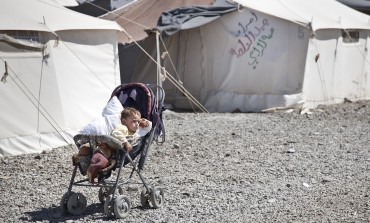 Greenpeace Jordan recently launched its first report specific to the Arab World entitled Jordan’s Energy Future (pdf link) to a packed audience of environmentalists, activists and political stakeholders in Amman. The report demonstrates Jordan’s potential to achieve full energy independence through renewable sources whilst campaigning against kingdom ambitions to develop nuclear energy. “This report shows the renewable power scenarios that can be implemented in Jordan without the need of a nuclear power plant. [It also] shows the obstacles and risks that can face the nuclear power plant in Jordan if implemented, “said Safa’ Al Jayoussi, Greenpeace Climate and Energy Campaigner in Jordan.
Greenpeace Jordan recently launched its first report specific to the Arab World entitled Jordan’s Energy Future (pdf link) to a packed audience of environmentalists, activists and political stakeholders in Amman. The report demonstrates Jordan’s potential to achieve full energy independence through renewable sources whilst campaigning against kingdom ambitions to develop nuclear energy. “This report shows the renewable power scenarios that can be implemented in Jordan without the need of a nuclear power plant. [It also] shows the obstacles and risks that can face the nuclear power plant in Jordan if implemented, “said Safa’ Al Jayoussi, Greenpeace Climate and Energy Campaigner in Jordan.
The report’s authors, Stephen Thomas and Shukri Halaby, have a two-prong aim: to refute the argument that only nuclear power can provide requisite capacity at low cost, and demonstrate that nuclear generation is not an essential part of Jordan’s future energy mix.
The report states:
“Renewable energy resources – particularly solar – can technically provide sixty times more than Jordan’s electricity consumption in 2050. More important, is that the economics of solar and wind is feasible today, and with the declining cost structure of these technologies, they will be at and below cost parity with other indigenous fossil fuel based power generation. Economic modelling results show that a target of 100% renewable energy by 2050 can be attained and can lead to total accumulated savings of approximately $80 billion (or $12 billion in present value terms), while providing 30,000 new jobs.”
Jordan’s Energy Sector Strategy, established in 2007, planned integration of renewables into the national energy grid at 7% capacity by 2015 and 10% by 2020. But continued dependence on subsidized natural gas (imported from Egypt) has undermined meaningful progress in both development of renewable energy projects and efforts to mandate energy efficiency. As of 2011, the government had failed to initiate any significant steps towards meeting renewable goals. There have been recent developments:
- Last April, Jordan’s Parliament adopted the Renewable Energy and Energy Efficiency Law (REEL), primarily aimed at inciting private-sector investment in Jordan’s nonexistent commercial renewable energy sector.
- Regulations come into effect this April making solar water heaters obligatory for every new residence (including apartments) sized 150 m2 or greater. Private houses sized a minimum of 250 m2 and office spaces sized a minimum 100 m2 must also comply.
- A feed-in-tariff, allowing residents to sell domestically produced power back to the national grid, was recently adopted: although it’s a bit of a Trojan Horse given that so few homes are geared up to generate solar energy. The Ministry of Energy and the Jordan River Foundation have teamed up to provide $1.8 million in loans to purchase and install all necessary equipment, but in this nation where many scramble to fuel their cars and warm their houses, there is scant interest or ability to invest in new technology.
Meanwhile, the Jordan Atomic Energy Commission is working to bring 4GW of nuclear generation online by 2030, sufficient capacity to serve over 50% of Jordan’s anticipated consumption requirements. The first of these plants, planned to go live in 2020, has been stalled in part by strong public opposition.
The Greenpeace report calls for urgent renewables development, citing repeated disruption of Egyptian gas supplies, uncertain pricing, and the unattractive contingency of shifting to imported oil derivatives that come with even higher price tags.
Greenpeace continues to emphasize on the need for a full national strategy to lessen reliance on foreign energy imports through renewable energies making this the most viable substitute to nuclear and carbon energy.
Image of anti-nuclear protestor via Greenpeace Jordan facebook page



Please, i am very concerned about the nuclear issue. I strongly recommend if you make a petition through Avaaz, or onine, even by a facebook page or link-directed small website, or all three, you will gat a LOT more petitions. Because if the Jordanian population were asked for a refwerendum on this it would be overturned in a day. Please consider what I am saying. It is vital to the health of the country and future generations. Please take the time to do this before aubmitting the petition. 9000 people is a very small number. If it went out online it would be 100 times more if done properly. Bless and thanks for what you are doing.
Bahjat,
I see the view of Professor Steven Thomas (Professor of Energy Policy at Greenwich University) regarding nuclear energy, as one of someone who does not see Jordan as having neither the capability nor the technology to build a project such as this.
I agree with your statement “…you can clearly see between the lines; suffice to say, his views are neither mainstream nor universally accepted globally…”
Jordan’s energy needs can be met through a combination of both Solar & Nuclear power. The Jordanian government should allow the private sectors to undertake a sizeable project such as this! As you suggested, the Government of Jordan can have a small stake in it, but the private sectors “enterprise companies” can build and operate it for, let’s say, 50 years until they have recouped all of their investment. After such time it can be returned back to Jordan Nuclear Power Plant (JNPP).
Who knows, maybe they can even sell the electricity to other countries in the region.
The report is riddled with its own flaws. The work of Steven Thomas (professor of energy policy at Greenwich University) can clearly be seen between the lines: suffice to say, his views are neither mainstream nor universally accepted globally.
The fundamental flaw however is in suggesting that PV, CSP and Wind along with more efficient energy practices can satisfy Jordan’s electricity needs by 2050. It is wishful thinking at best. The problem is, CSP is not even ready for deployment and still costs more per kWh than petroleum-derivatives such as heavy-fuel-oil or diesel.
On the other hand PV/CPV is very ‘day-limited’ and although one could in theory use a day-night mix (PV/CPV during the day) while relying on burning fossil fuels at night (i.e. where thermal efficiency is higher and losses reduced) until CSP is ready for 24/7 deployment. Finally while wind power can in theory reduce the need for fossil fuels (a CPV-Wind-Fossil fuel; the latter being phase-out when CSP is fully ready for commercial deployment) is interesting conceptually: but not likely to work.
Another issue is the nature of the nuclear project itself.
The government is UNWILLING to invest in the nuclear project (or really renewables) because the market itself has been set for Independent Power Producers (IPPs). Thus, while the government may own a small stake, the private-sector would drive the Jordan Nuclear Power Plant(JNPP) and would sell electricity to the main grid providers.
As such, it’s not like we’re discussing ‘government money’ (if anything the nuclear utility has to pay back government bonds).